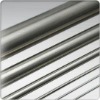- Cast & Forged[8]
- Steel Round Bars[6]
- Titanium Pipes[1]
- Nickel[2]
- Other Wire Mesh[1]
- Ultrasonic[2]
- Other Metals & Metal Products[2]
- Dental Equipments[7]
- Implants & Interventional Materials[1]
- Springs[8]
- Magic Tricks[6]
- Other Toys & Hobbies[1]
- Communication Cables[1]
- Stainless Steel Strips[1]
- Body Fluid-Processing & Circulation Devices[1]
- Sunglasses[2]
- Contact Person : Mr. Jason Leo
- Company Name : Shenyang Tim-High Material Development Co., Ltd.
- Tel : 0086-24-24697207
- Fax : 0086-24-24697065
- Address : Liaoning,Shenyang,17 Wensu ST HunNan Shenyang
- Country/Region : China
- Zip : 110168
memory alloy wire of 302
Melt Practice
We offer this high quality austenitic stainless steel for spring applications. To keep costs at a minimum this alloy is supplied from an electric-arc air melted process. Localized variations in chemistry can cause slight changes in ultimate tensile strength when drawing to fine wire.
Typical Chemistry
| FWM Avg. Wt. % | ASTM A313 |
Carbon | 0.10 | 0.12 |
Manganese | 1.11 | 2.00 |
Silicon | 0.52 | 1.00 |
Phosphorus | 0.023 | 0.045 |
Sulfur | 0.002 | 0.030 |
Chromium | 18.60 | 17.0-19.0 |
Nickel | 8.40 | 8.00-10.00 |
Molybdenum | 0.32 | - |
Copper | 0.36 | - |
Nitrogen | 0.03 | 0.10 |
Iron | Balance | Balance |
Cobalt | 0.16 | - |
FWM chemistry is for reference only, and is not to be used for specification purposes.
Physical Properties
Density | 0.285 lbs/in3 |
Modulus Of Elasticity | 28.0 psi x 106 |
Electrical Resistivity | 720 µohms-mm |
Thermal Conductivity | 16.3 W/mK (100°C) |
Thermal Treatment
In wire form, cold worked 302 will gain tensile strength when stress relieved at 350-427°C for 4-6 hours. A reducing atmosphere is preferred, but inert gas can be used. 302 will fully anneal at 1010-1121°C in just a few minutes. There is a carbide precipitation phenomenon that occurs between 427 and 899°C that reduces the corrosion resistance of the alloy. American Society for Testing Materials (ASTM) has described a test method to ensure the alloy has not been damaged.
Applications
302 alloy is the same as 304 alloy except for the 0.12% carbon maximum. In 304 the maximum carbon is 0.08%. Technically, all 304 alloys meet the requirements of 302 alloys, but not all 302 can meet 304 chemistry. Practically, this means in general 302 is harder than 304 with the same amount of cold work. End uses for 302 include: stylets, catheters, guide wires, springs and needles.
Mechanical Properties
%CW | Y.S.(psi) | U.T.S.(psi) | % Elongation (10" gauge length) |
0% | 49,000 | 106,000 | 48% |
20% | 125,000 | 147,000 | 9.8% |
37% | 169,000 | 189,000 | 3.2% |
50% | 196,000 | 220,000 | 2.6% |
60% | 222,000 | 244,000 | 2.2% |
68% | 243,000 | 273,000 | 2.1% |
75% | 251,000 | 289,000 | 2.4% |
80% | 282,000 | 309,000 | 2.2% |
84% | 295,000 | 327,000 | 2.2% |
87% | 300,000 | 332,000 | 2.3% |
90% | 319,000 | 345,000 | 2.2% |
92% | 322,000 | 371,000 | 2.5% |
Values are typical and may not represent all diameters. Test method will affect results.
Surface Condition
Stainless steels develop a highly polished appearance as they are drawn to fine diameters. Surface roughness can be less than 5 RMS when processed using SCND* dies and measured with a profilometer. Diameters over 0.040" are finished with polycrystalline dies and exhibit a rougher surface than natural diamond dies. Diameters over 0.100" will have an even rougher surface because they are drawn with carbide dies.
memory alloy wire of 302


